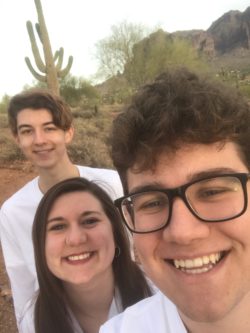Clinical Research Fastrack’s own Maddie Clark tells her story about how clinical research has affected her family’s life.
The Broad Reach of Epilepsy
Epilepsy has started to appear in the news more and more recently. Cannabis oils are now being used to manage seizures and as the use of Cannabis is legalized, this treatment is becoming more popular for those suffering from epileptic seizures. The cause of seizures remains a mystery to us in many cases and the media and fanatics of all kinds tend to jump to extreme treatments as potential solutions. Despite the hype, not many treatments have made it through the rigorous clinical trial approval process.
This leaves hundreds of thousands of people without answers. This is all the more terrifying considering that, according to the Epilepsy Foundation, one in every 26 people will develop epilepsy at some point in their life.
My brother happened to be one of the 26.
My family had never interacted with or thought about clinical research prior to him developing epilepsy. With the cause of his seizures being such a large question mark, enrolling in an epilepsy research trial would have been a fantastic option for Simon. However, because we didn’t have the proper access to clinical research information or options, we ended up marching forward with the trial and error medications being offered to us.
The cocktail of medications he ended up taking were just as detrimental as the seizures.
A Holiday Disaster
It was Christmas day 2012 the first time I witnessed a seizure.
Though I was a cool 18-year-old at the time, I had gotten up at the crack of dawn with my two younger brothers to see what presents awaited us. Within just a couple of hours, the three of us were sitting in a wreckage of wrapping paper and gifts.
My parents had walked out of the room to get dressed for the day, and I was left sitting with Garrett, my youngest brother at 10, and Simon, who was 13. Simon was asleep on the couch, laying on an oversized stuffed bear he had received. Garrett and I were sitting on the floor watching a Christmas special on TV.
I thought nothing of Simon being asleep – he had made it a tradition to try and stay up as late as possible on Christmas Eve. Originally it was to try and catch Santa in the act, but it eventually developed into a personal challenge for himself. I let him rest, as he had been through a lot that year.
In March Simon had had his first seizure, just a few months before his 13th birthday. The only witness to his first one was my nine-year-old brother, Garrett, who won’t speak about the event to this day.
By Christmas, Simon had already switched antiepileptic medications three times, had dozens of hospital visits filled with scans, blood tests, and overnight observations. Nothing was determined besides that yes, he was seizing – sometimes when we couldn’t even see it.
That day, though, the seizures made themselves known.
Too quickly, Simon started making a choking noise from where he lay on the couch. His muscles all tightened as if he was being electrocuted, and he started shaking violently. His head was jerking back, his jaw pushed out, like someone was yanking him from the back of his head.
I had never seen anything like it.
I don’t remember either Garrett or myself making a noise to alert her, but suddenly my mom was in the room turning Simon onto his side and putting him into a recovery position. She kept repeating “It’s okay, it’s okay,” but I couldn’t tell who she was chanting it for.
After what felt like an eternity, Simon lay still. His eyes fluttered open, and his dilated pupils made him look alien and strange.
“It’s okay,” my mom said again, this time directly to him. “You’re alright. You just had a seizure, but it’s okay. Go upstairs and change, splash some water on your face, and we’ll take you to the doctor.” He nodded slowly, and stood up even slower.
We’d gotten used to Simon not being himself by this point. He’d been having seizures, sometimes multiple a day, for almost nine months. If that wouldn’t cause a person to change, the cocktail of medications he was filled with certainly did.
Since the doctors didn’t know what was wrong with him they just kept giving him different pills and waiting to see what happened. In less than a year, he went through: Keppra, Topamax, Divalproex, Depakote, and Lamictal, to name a few.
With so many medications, he developed depression and anxiety and, most frighteningly, started hallucinating. For awhile he was taking more than four pills a day, ranging from antiepileptics to antipsychotics, and was still expected to go to school.
It was nightmarish, and Simon would often describe himself as being “in a fog,” unable to interact with the world correctly.
After my mom had sent Simon off to change, she had turned her attention to Garrett to comfort him. I decided to follow Simon up the stairs. I was in shock at having witnessed my first seizure, and everything felt like a dream. I remembered hearing my dad talk to Simon as he entered his room to get ready for the doctor, and I wanted to tell him about what I saw.
As I reached the top of the stairs my dad and I only had the chance to say a handful of words to each other, which I can’t remember now. In a moment of terrifying coincidence, we were both close enough to the door to hear a thump from Simon’s room. Simultaneously, our dog started barking frantically trying to break down his door.
In a whirlwind of movement, Simon’s bedroom door was thrown open to reveal him seizing on the floor, facedown. Upon flipping him over, I saw he was a shade of terrifying blue. He had stopped breathing, and my dad was shaking him violently trying to reopen his airways.
“Call an ambulance,” someone screamed, and I dialed 911 for the first time in my life.
He was picked up and on his way to the hospital in less than a half an hour, but that morning took years away from us all. I found out later that he had five more seizures in the fifteen-minute ride to the hospital, and was then unconscious for more than a day.
The Lasting Impact of Fear
 Growing up we had always known he was a “spacey” kid – he had trouble paying attention, he would “zone out” during school, and never had an explanation as to why he couldn’t focus. It wasn’t until he started having physical seizures (called “grand mal” seizures) in seventh grade that we were told he’d probably been seizing for years before that, maybe even since he was a baby.
Growing up we had always known he was a “spacey” kid – he had trouble paying attention, he would “zone out” during school, and never had an explanation as to why he couldn’t focus. It wasn’t until he started having physical seizures (called “grand mal” seizures) in seventh grade that we were told he’d probably been seizing for years before that, maybe even since he was a baby.
“Petit mal” or absence seizures looked just like spacing off or zoning out, but underneath the brain is losing control, seizing, and causing a brief, undetectable unconsciousness.
He had his brain scanned more times than I could count that year, and doctors couldn’t pinpoint a single thing that was wrong with him. He was having seizures, sure, but he was an otherwise completely healthy kid. The best diagnosis they could give was generalized epileptic syndrome: a catch-all for the cases that left physicians scratching their heads.
The medical world still really doesn’t know much about epilepsy, and about one-third of all epileptics are categorized with generalized epileptic syndrome. Until recently, the only solution was to try a handful of different medications until one worked, which would often lead to a whole host of other issues.
For Simon, it caused extreme anxiety and depression, even after his seizures stopped and was taken off the antiepileptics. He had been taking extremely potent medication before even entering high school, during an integral time for his brain development.
We were lucky he came out of the ordeal fully-functioning, as it was common just a couple of decades earlier for anti-seizure medication to severely stunt the brain, and leave patients developmentally disabled.
Medicine had come a long way since then, and it’s still being propelled further as we move towards the future.
Hope Restored Through Clinical Research
Just last week, a Phase-2a epilepsy trial dedicated to helping people like my brother enrolled its first patient. This trial is specifically trying to target adolescents and young adults with drug-resistant generalized epileptic syndrome.
“New treatment options to control generalized seizures and maintain quality of life for patients and their families are particularly needed, as there are limited options currently available. New treatments for generalized epilepsy would provide a significant opportunity to help adolescents and young adults,” said Dr. Jacqueline French, Chief Scientific Officer at the Epilepsy Foundation and Professor of Neurology at NYU School of Medicine.
Trials like these are an unbelievably important step towards allowing people with this condition to live happy, carefree life. Though it’s still in its infancy, this clinical trial gives hope to those still living everyday with the fear of seizures hanging over them. Maybe someday soon they’ll be able to know a life they’re able to control.
Maybe soon their seizures will be a nightmare they can wake up from.
Maybe, but not without the pivotal clinical research being conducted.


